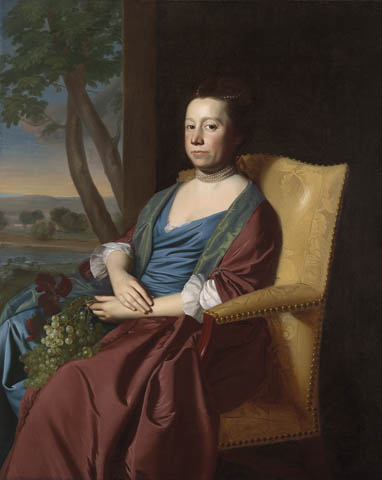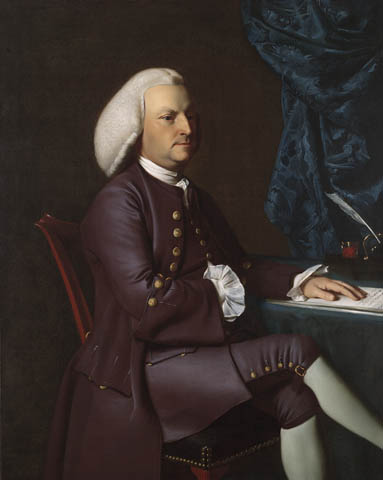Jennifer M. Ports
Much can be learned about class and gender in colonial America through portraits. In colonial America most of the images created were meant to document people and places. For this reason you will find mostly natural history drawings and oil paintings of people and their families from this time period. The images of nature were meant to educate Europeans on the New World, and portraits would bring families together and preserve the family legacy. Although other types of oil paintings did exist in Europe, in colonial America only portraits and images of nature were painted. Patrons would commission painters to paint these portraits of one or more members of the family. Price, size, and number of figures within each painting would be negotiated and the figures would sit for hours over a long period of time as their portrait was completed. Some of the money would be paid upfront, and the rest when the job was complete. Historians know that "the artist rendered what he observed and what he knew to be the key ingredients of social identity in his culture," and that the painting would not be considered done or paid for until the patron stated they were satisfied with the result. If they were not, changes would be made until the patron was happy, and today historians use technical analysis and X–rays to study these adjustments.
1
For these reasons it is important to teach students that these paintings were created, manipulated images. Just as history teachers teach students to identify author, audience, tone, intent, main ideas, supporting details, and time of creation when analyzing texts, students must be taught to do so when examining colonial art. Doing this is an important step to unlocking meaning from any piece.
So much can be learned about colonial society, specifically family life, gender, and social class, from examining colonial portraits that have survived to today. Images I have found to be enlightening when studying gender in class in the early colonial period are as follows:
John Freake
,
Mrs. Freake and Baby Mary
,
The Mason Children: David, Joanna, and Abagail
, all by an anonymous painter known as the "Freake–Gibbs Painter" and done between 1671–1674. During this period there was a strong Puritan presence in New England, and these paintings are very informative of how men, women, and children lived, what was expected of them, and what they valued during the early colonial American period. Another applicable portrait that is great for study of gender and class in early Colonial America is the self portrait of Captain Thomas Smith. Other images worth studying, and that were painted a little later in the colonial period, are John Smibert,
Dean Berkeley and His Entourage (The Bermuda Group)
(1729, Yale University Art Gallery), John Singleton Copley,
Nicholas Boylston
(1767, Harvard University Portrait Collection), John Singleton Copley,
Mrs. Thomas Gage (Margaret Kemble Gage)
(1771, Timken Museum of Art), John Greenwood,
Elizabeth Moffatt Sherburne
(1750, Yale University Art Gallery), John Singleton Copley,
Portrait of Jeremiah Lee
(1769, Wadsworth Antheneum Museum of Art), John Singleton Copley,
Portrait of Mrs. Jeremiah Lee (Martha Swett)
(1769, Wadsworth Antheneum Museum of Art), Charles Willson Peale,
William Buckland
(1774 and 1789, Yale University Art Gallery), Benjamin West,
Charles Willson Peale
(1767–1769, New York Historical Society), John Singleton Copley,
Mr. Isaac Smith
(1769, Yale University Art Gallery), and John Singleton Copley,
Mrs. Isaac Smith (Elizabeth Storer)
(1769, Yale University Art Gallery), and John Singleton Copley,
Portrait of Paul Revere
(1768, Museum of Fine Arts in Boston).

Mrs. Isaac Smith

Mr. Isaac Smith
As alluded to before, while in the 17th century people bought other luxury goods rather than commission paintings, in the 18th century more colonial Americans were commissioning paintings that were still intended only for private enjoyment and had no value as a commodity. The first set of paintings mentioned are from this earlier period than the ones mentioned later. On this note it would be valuable to point out to students how this differs from today, and discuss why people do not commission painters anymore, and if they did, to imagine how their negotiations and sessions with the painter might go. Also, a focus on the life and works of John Singleton Copley would make for great discussion when studying portraiture of the colonial American period.
In the classroom there are multiple ways to get students engaged with these ideas. As educators we know the importance of making all that students learn relevant to their lives. The connections students make between what they are learning in class and their daily lives helps engage them in the subject, as well as helps them remember what they learn. To engage students with the themes of class and gender, the teacher could start by showing the students a photograph or other image of a well known figure today, perhaps a movie star or artists they are all familiar with. The teacher could have students examine the image and then discuss questions that help them identify how this person is portrayed in this image, and aspects of the image make them believe so. Would the person portrayed like how they are portrayed, why or why not? When was the image created? Who created it and who was the intended audience? What do you suppose this person is like? What do they value? Having students answer these questions of a modern day portrait, a familiar time period, might help them then answer these similar questions for portraits from colonial America. It can also help them ask deeper questions of the time.
Through careful observation of the 17th and 18th century paintings mentioned earlier one can see what the portrayed person, or people, valued as a member of their class and gender. Questions to ask of these portraits that speak to gender and class would be: How are the men portrayed verses the women, and what might that says about gender roles of this time period? What does the body language of the people portrayed communicate? What objects were chosen to be portrayed with the painted and why do you think they were chosen? What do the objects in the foreground and background communicate to the viewer? What does the body language of the people portrayed communicate? How do these people seem to want to be portrayed? What social class are the portrayed a part of and how do we know? These questions can be asked of each of the mentioned portraits and help students draw conclusions about gender and class from the time period through discussion and supplemental readings that will enhance, shape, guide, or reinforce interpretations of the paintings made by students. Doing a comparative exercise where students compare and contrast modern portraits of well known people today to some of the portraits from the 18th century could be valuable as well, especially to help students see that both sets of images are interpretations of reality. Since this unit if for a US History classroom, perhaps any of President Obama's campaign portraits would work. Having students compare and contrast class and gender as depicted in images from the colonial time period could help them solidify and deepen their understanding of these themes in colonial America. At the same time having students compare and contrast these themes as depicted in images from both the 18th century and today could really help them to connect to the material. The teacher can decide which points they most want their students to take away and choose pairs of images for students to analyze that would most highlight the ideas they want their students to understand.
It could also be beneficial to have students compare men to women as they are depicted in 18th century art, particularly since it speaks so strongly to gender roles of the time. Students in the class could be asked to recreate the images they see in a tableau as well. This could be really fun in the classroom with a painting of a family too. Student groups could be asked to position their members to mirror the painting and could take turns coming to life from the painting to explain who they are, their social class and their gender role within their family. Even if students do not have all the facts about the painting and its subject(s) before had, they could have fun speculating based on what they see then have the teacher tell the story of the image afterward. Whether they are speculating or using the information to do this exercise, it would be very engaging for students. Students could also be given the chance to design or create their own portraits. After discussing the pieces students could then decide how they would want to be depicted in a portrait then try to decide what objects, scenery, people, etc. they might include in order to make themselves appear that way. This would also be a great way to introduce the process of commissioning a painting and get them to personally connect with the material.